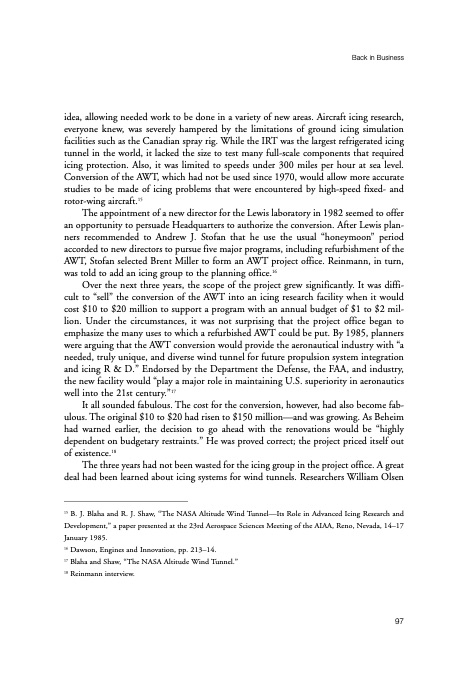
PDF Publication Title:
Text from PDF Page: 109
idea, allowing needed work to be done in a variety of new areas. Aircraft icing research, everyone knew, was severely hampered by the limitations of ground icing simulation facilities such as the Canadian spray rig. While the IRT was the largest refrigerated icing tunnel in the world, it lacked the size to test many full-scale components that required icing protection. Also, it was limited to speeds under 300 miles per hour at sea level. Conversion of the AWT, which had not be used since 1970, would allow more accurate studies to be made of icing problems that were encountered by high-speed fixed- and rotor-wing aircraft.15 The appointment of a new director for the Lewis laboratory in 1982 seemed to offer an opportunity to persuade Headquarters to authorize the conversion. After Lewis plan- ners recommended to Andrew J. Stofan that he use the usual “honeymoon” period accorded to new directors to pursue five major programs, including refurbishment of the AWT, Stofan selected Brent Miller to form an AWT project office. Reinmann, in turn, was told to add an icing group to the planning office.16 Over the next three years, the scope of the project grew significantly. It was diffi- cult to “sell” the conversion of the AWT into an icing research facility when it would cost $10 to $20 million to support a program with an annual budget of $1 to $2 mil- lion. Under the circumstances, it was not surprising that the project office began to emphasize the many uses to which a refurbished AWT could be put. By 1985, planners were arguing that the AWT conversion would provide the aeronautical industry with “a needed, truly unique, and diverse wind tunnel for future propulsion system integration and icing R & D.” Endorsed by the Department the Defense, the FAA, and industry, the new facility would “play a major role in maintaining U.S. superiority in aeronautics well into the 21st century.”17 It all sounded fabulous. The cost for the conversion, however, had also become fab- ulous. The original $10 to $20 had risen to $150 million—and was growing. As Beheim had warned earlier, the decision to go ahead with the renovations would be “highly dependent on budgetary restraints.” He was proved correct; the project priced itself out of existence.18 The three years had not been wasted for the icing group in the project office. A great deal had been learned about icing systems for wind tunnels. Researchers William Olsen Back in Business 15 B. J. Blaha and R. J. Shaw, “The NASA Altitude Wind Tunnel—Its Role in Advanced Icing Research and Development,” a paper presented at the 23rd Aerospace Sciences Meeting of the AIAA, Reno, Nevada, 14–17 January 1985. 16 Dawson, Engines and Innovation, pp. 213–14. 17 Blaha and Shaw, “The NASA Altitude Wind Tunnel.” 18 Reinmann interview. 97PDF Image | History of NASA Icing Research Tunnel

PDF Search Title:
History of NASA Icing Research TunnelOriginal File Name Searched:
sp4226.pdfDIY PDF Search: Google It | Yahoo | Bing
NFT (Non Fungible Token): Buy our tech, design, development or system NFT and become part of our tech NFT network... More Info
IT XR Project Redstone NFT Available for Sale: NFT for high tech turbine design with one part 3D printed counter-rotating energy turbine. Be part of the future with this NFT. Can be bought and sold but only one design NFT exists. Royalties go to the developer (Infinity) to keep enhancing design and applications... More Info
Infinity Turbine IT XR Project Redstone Design: NFT for sale... NFT for high tech turbine design with one part 3D printed counter-rotating energy turbine. Includes all rights to this turbine design, including license for Fluid Handling Block I and II for the turbine assembly and housing. The NFT includes the blueprints (cad/cam), revenue streams, and all future development of the IT XR Project Redstone... More Info
Infinity Turbine ROT Radial Outflow Turbine 24 Design and Worldwide Rights: NFT for sale... NFT for the ROT 24 energy turbine. Be part of the future with this NFT. This design can be bought and sold but only one design NFT exists. You may manufacture the unit, or get the revenues from its sale from Infinity Turbine. Royalties go to the developer (Infinity) to keep enhancing design and applications... More Info
Infinity Supercritical CO2 10 Liter Extractor Design and Worldwide Rights: The Infinity Supercritical 10L CO2 extractor is for botanical oil extraction, which is rich in terpenes and can produce shelf ready full spectrum oil. With over 5 years of development, this industry leader mature extractor machine has been sold since 2015 and is part of many profitable businesses. The process can also be used for electrowinning, e-waste recycling, and lithium battery recycling, gold mining electronic wastes, precious metals. CO2 can also be used in a reverse fuel cell with nafion to make a gas-to-liquids fuel, such as methanol, ethanol and butanol or ethylene. Supercritical CO2 has also been used for treating nafion to make it more effective catalyst. This NFT is for the purchase of worldwide rights which includes the design. More Info
NFT (Non Fungible Token): Buy our tech, design, development or system NFT and become part of our tech NFT network... More Info
Infinity Turbine Products: Special for this month, any plans are $10,000 for complete Cad/Cam blueprints. License is for one build. Try before you buy a production license. May pay by Bitcoin or other Crypto. Products Page... More Info
| CONTACT TEL: 608-238-6001 Email: greg@infinityturbine.com | RSS | AMP |